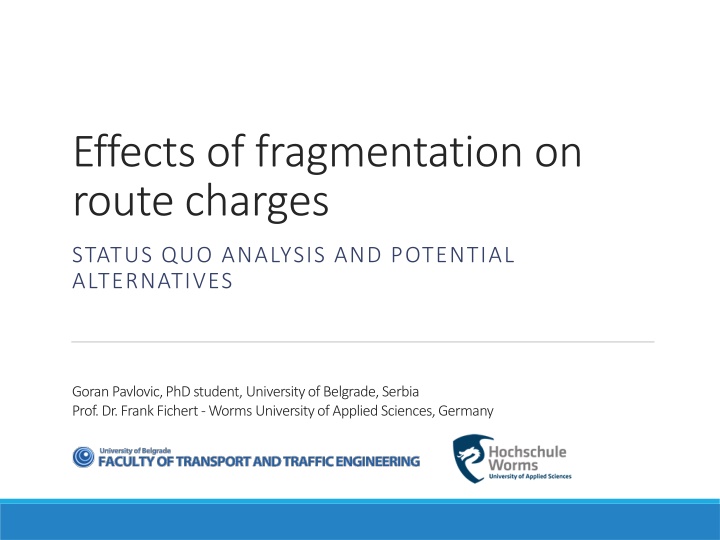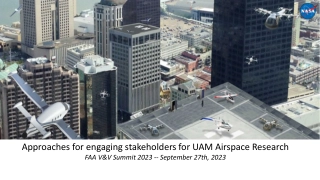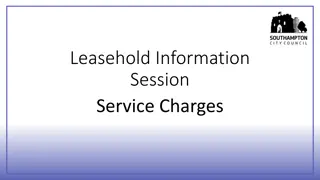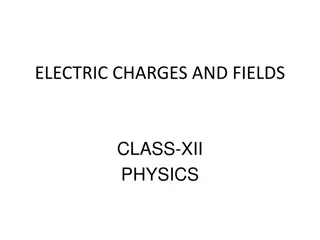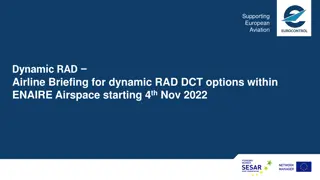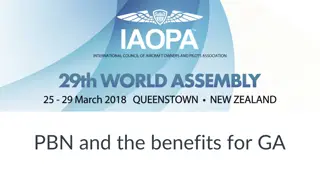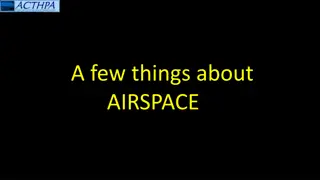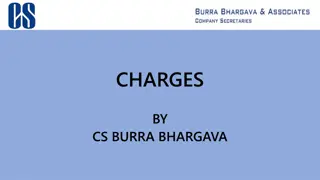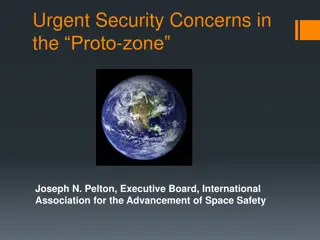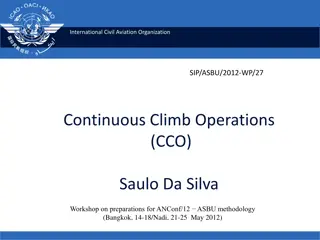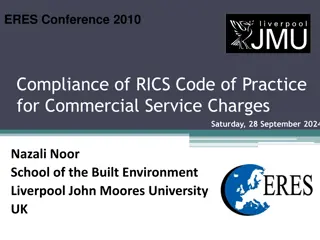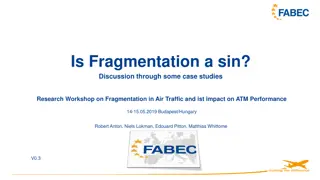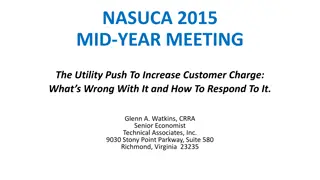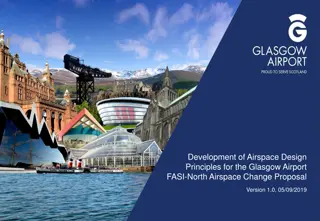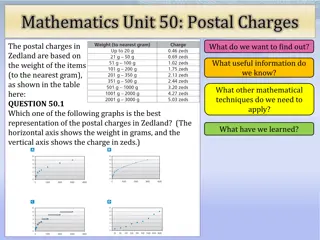Impact of Fragmentation on Route Charges in European Airspace
The study analyzes the effects of fragmentation on route charges, focusing on the current route charging system in Europe and the challenges of airport-pair charging. It discusses the negative impacts of detours around charging zones, explores potential alternatives in pricing mechanisms, and addresses factors affecting route choice. Estimation of route charge variability on an airport-pair level is also discussed. The research aims to provide insights into optimizing route charges and improving operational efficiency in air navigation services.
Download Presentation

Please find below an Image/Link to download the presentation.
The content on the website is provided AS IS for your information and personal use only. It may not be sold, licensed, or shared on other websites without obtaining consent from the author.If you encounter any issues during the download, it is possible that the publisher has removed the file from their server.
You are allowed to download the files provided on this website for personal or commercial use, subject to the condition that they are used lawfully. All files are the property of their respective owners.
The content on the website is provided AS IS for your information and personal use only. It may not be sold, licensed, or shared on other websites without obtaining consent from the author.
E N D
Presentation Transcript
Effects of fragmentation on route charges STATUS QUO ANALYSIS AND POTENTIAL ALTERNATIVES Goran Pavlovic, PhD student, University of Belgrade, Serbia Prof. Dr. Frank Fichert - Worms University of Applied Sciences, Germany
Background and motivation Current Central Route Charges Office (CRCO) route charging scheme negative effect of aircraft taking (or at least filing) detours around charging zones with higher unit rates (Delgado, 2015). Policy negatively impacting operations! Fuel , CO2 , traffic shifts etc. Ongoing discussions on innovative charging and pricing mechanisms: o Airport-pair charging: e.g., FRIDAY, Verbeek, 2015 o Uniform (common) route charge: Wise Persons Group Report on the future of SES, April 2019 2 PAVLOVIC / FICHERT - WORKSHOP FRAGMENTATION - BUDAPEST, 14/15 MAY 2019
Current route charging system in Europe EUROCONTROL CRCO Charging zones (CZ) with corresponding unit rates Three basic elements: o Unit rate for each CZ o Distance factor o Aircraft Weight Factor service unit *Data from June 2016 Unit rates vary in space, but also in time: o Changes in traffic flows o Changes in cost base o Changes in exchange rates forecast cost base forecast service units Unit rate = 3 PAVLOVIC / FICHERT - WORKSHOP FRAGMENTATION - BUDAPEST, 14/15 MAY 2019
Challenges of airport-pair charging How to define an airport-pair charge in order to recover the costs of individual Air Navigation Service Providers (ANSPs) involved in service provision for a particular airport-pair, given the uncertainty in the demand distribution over the network? Cost-relatedness principle! Factors affecting route choice: Internal: A/C type, Cost Index, flight planning practices etc. External: weather, congestion, fuel price, route network structure and availability, route charges system etc. 4 PAVLOVIC / FICHERT - WORKSHOP FRAGMENTATION - BUDAPEST, 14/15 MAY 2019
Estimating route charge variability on an airport pair level Airport-Pair Unit Rate (APUR) - the unit cost of ANS provision for accommodating traffic demand on a given airport-pair: Airport-Pair Variability Indicator (APVI): APVI = standard deviation (APUR)* *across the daily/weekly/monthly or even yearly APUR values 5 PAVLOVIC / FICHERT - WORKSHOP FRAGMENTATION - BUDAPEST, 14/15 MAY 2019
Impact of ATM fragmentation - analysis Timeframe: 61 summer days (June and July 2016) Geographical scope: flights within, to/from Europe Trajectory type: last-filed flight plan trajectories (Eurocontrol DDR service) Initial traffic: 1,999,713 flights and ca. 79,000 airport-pairs Filter: airport-pairs with >= 10 days of traffic Final dataset: 1,768,992 flights and 20,677 airport-pairs - 88% of the initial traffic demand. Directions considered separately (A-B B-A) APVI calculated as a standard deviation over the daily APUR values! 6 PAVLOVIC / FICHERT - WORKSHOP FRAGMENTATION - BUDAPEST, 14/15 MAY 2019
Results charging zones overflown per flight Large portion of flights stay within 3 charging zones ( 62%) 7 PAVLOVIC / FICHERT - WORKSHOP FRAGMENTATION - BUDAPEST, 14/15 MAY 2019
Results APVI values for Intra- European pairs *Each dot in the plot corresponds to one airport-pair 8 PAVLOVIC / FICHERT - WORKSHOP FRAGMENTATION - BUDAPEST, 14/15 MAY 2019
Results geographical distribution of APVI 9 PAVLOVIC / FICHERT - WORKSHOP FRAGMENTATION - BUDAPEST, 14/15 MAY 2019
Results - airport-pairs with high APVI values Outliers: APVI > 5 EUR 10 PAVLOVIC / FICHERT - WORKSHOP FRAGMENTATION - BUDAPEST, 14/15 MAY 2019
Results APVI vs number of charging zones crossed Example: APVI increases with the route distance and number of (potential) charging zones crossed 11 PAVLOVIC / FICHERT - WORKSHOP FRAGMENTATION - BUDAPEST, 14/15 MAY 2019
Results APVI vs major flows 12 PAVLOVIC / FICHERT - WORKSHOP FRAGMENTATION - BUDAPEST, 14/15 MAY 2019
Options for charging scheme Charging based on filed flight plan Charging based on actual route ANSP specific unit rates Uniform unit rate Current scheme: Incentives to file longer routes to avoid zones with high unit rates Options for gaming (intention to deviate from filed flight plan) 13 PAVLOVIC / FICHERT - WORKSHOP FRAGMENTATION - BUDAPEST, 14/15 MAY 2019
Options for charging scheme Charging based on filed flight plan Charging based on actual route ANSP specific unit rates Uniform unit rate Different unit rates based on actual route: No more options for gaming / better predictability More complicated administration (airline accounting) Incentives to fly longer routes to avoid zones with high unit rates remain 14 PAVLOVIC / FICHERT - WORKSHOP FRAGMENTATION - BUDAPEST, 14/15 MAY 2019
Options for charging scheme Charging based on filed flight plan Charging based on actual route ANSP specific unit rates Uniform unit rate Uniform unit rate: No incentives to file/fly longer routes to avoid zones with high unit rates Charges do not reflect different costs Redistribution of revenue necessary Costs for operating flights in different European regions change 15 PAVLOVIC / FICHERT - WORKSHOP FRAGMENTATION - BUDAPEST, 14/15 MAY 2019
Options for charging scheme Airport pair charges: Fixed charge for each airport-pair (only MTOW dependent) No incentive to fly longer routes in order to save charges (but maybe other reasons, e.g. weather) No incentive to file flight plans not in line with airlines preferences (but maybe other reasons, e.g. regulations) Key question: How should the airport-pair charge be determined? Weighted average of ANSPs unit rates, in order to allocate revenue based on cost as well as use of service provision 16 PAVLOVIC / FICHERT - WORKSHOP FRAGMENTATION - BUDAPEST, 14/15 MAY 2019
Options for charging scheme B Airport pair charges: A C Different options for weights: Shortest (plannable) route (A) Most commonly used route (B) Average of actually used routes ( 1*A + 2*B + 3*C) APUR APUR enables cost related revenues, similar to current scheme However, traffic pattern might change (compared to status quo), since no more route choices determined by different unit rates 17 PAVLOVIC / FICHERT - WORKSHOP FRAGMENTATION - BUDAPEST, 14/15 MAY 2019
Summary and way forward Empirical analysis shows large variations in average unit rates on an airport pair level Not surprisingly, largest variations can be observed in regions with large differences between neighbouring ANSPs APUR might also serve as a weighting base for airport pair charges, avoiding disadvantage of choosing just one route Future research: Extend period for analysis (one year instead of two months) Compare several years (including analysis of APVI due to changing unit rates) 18 PAVLOVIC / FICHERT - WORKSHOP FRAGMENTATION - BUDAPEST, 14/15 MAY 2019
Thank you very much for your attention! 19 PAVLOVIC / FICHERT - WORKSHOP FRAGMENTATION - BUDAPEST, 14/15 MAY 2019
Save the date! Engage SESAR KTN Summer School Summer schools will include sessions on research methodologies as well as tutorials on key ATM concepts and challenges, including case studies and presentations of prominent SESAR exploratory research projects. A number of student travel bursaries are available to support student attendance. Belgrade, 9-13 September 2019 More info shortly on: www.engagektn.com 20 PAVLOVIC / FICHERT - WORKSHOP FRAGMENTATION - BUDAPEST, 14./15. MAY 2019
